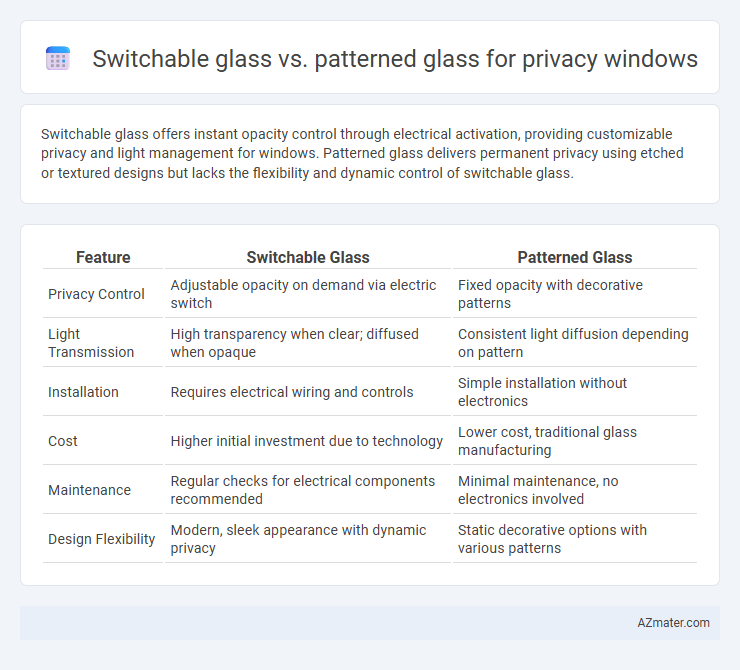Switchable glass offers instant opacity control through electrical activation, providing customizable privacy and light management for windows. Patterned glass delivers permanent privacy using etched or textured designs but lacks the flexibility and dynamic control of switchable glass.
Table of Comparison
| Feature | Switchable Glass | Patterned Glass |
|---|---|---|
| Privacy Control | Adjustable opacity on demand via electric switch | Fixed opacity with decorative patterns |
| Light Transmission | High transparency when clear; diffused when opaque | Consistent light diffusion depending on pattern |
| Installation | Requires electrical wiring and controls | Simple installation without electronics |
| Cost | Higher initial investment due to technology | Lower cost, traditional glass manufacturing |
| Maintenance | Regular checks for electrical components recommended | Minimal maintenance, no electronics involved |
| Design Flexibility | Modern, sleek appearance with dynamic privacy | Static decorative options with various patterns |
Introduction to Privacy Windows: Switchable vs Patterned Glass
Switchable glass offers dynamic privacy by electronically transitioning from transparent to opaque with a simple switch, ideal for adaptable spaces like offices and conference rooms. Patterned glass provides permanent privacy through etched or textured designs that obscure visibility while allowing natural light to filter through, commonly used in bathrooms and partitions. Both options enhance privacy but differ in functionality and aesthetic flexibility.
How Switchable Glass Works
Switchable glass, also known as smart glass, operates by applying an electric current to liquid crystal molecules embedded between glass panes, enabling instant transition between transparent and opaque states for privacy control. Patterned glass achieves privacy through frosted or etched textures that diffuse light and obscure visibility but remains permanently static. The dynamic functionality of switchable glass offers customizable privacy without sacrificing natural light, unlike the fixed obscuration of patterned glass.
Understanding Patterned Glass Technology
Patterned glass utilizes textured surfaces created through rolling or pressing techniques to distort visibility while allowing light transmission, making it a popular choice for privacy windows. This technology enables various designs and patterns to be embedded directly into the glass, enhancing aesthetics while maintaining opacity without compromising natural light. Unlike switchable glass that changes transparency electronically, patterned glass offers a permanent, low-maintenance privacy solution ideal for commercial and residential applications.
Privacy Levels: Switchable vs Patterned Glass
Switchable glass offers dynamic privacy by instantly changing from transparent to opaque with an electric signal, providing high levels of adjustable privacy suitable for offices and residential spaces. In contrast, patterned glass delivers static privacy through fixed textures or designs that obscure visibility but do not change, offering moderate privacy primarily through diffusion of light. While switchable glass enables customizable privacy control, patterned glass provides a cost-effective, permanent privacy solution without the need for electrical power.
Aesthetic Options and Design Flexibility
Switchable glass offers dynamic privacy control with a sleek, modern aesthetic that seamlessly transitions from transparent to opaque, enhancing design versatility for contemporary interiors. Patterned glass provides a wide variety of textures and motifs, enabling tailored decorative effects that complement traditional and artistic design schemes. Both options maximize privacy while allowing architects and designers to customize visuals according to functional and stylistic preferences.
Installation Process and Requirements
Switchable glass for privacy windows requires electrical wiring and integration with a control system to enable seamless opacity changes, often involving a professional installation due to its complexity and power needs. Patterned glass installation is more straightforward, involving standard glazing techniques without any electrical connections, making it compatible with most framing systems and easier for traditional window contractors. Both types demand precise measurements and proper sealing to ensure effective privacy and durability, but switchable glass installations generally require additional considerations for power supply and control integration.
Energy Efficiency and Light Control
Switchable glass offers superior energy efficiency by instantly adjusting opacity to control solar heat gain and optimize natural light, reducing reliance on artificial heating and cooling systems. Patterned glass provides consistent diffusion of light to maintain privacy but lacks dynamic modulation of solar energy, often resulting in higher energy consumption. For privacy windows, switchable glass enhances light control and energy savings by adapting to changing environmental conditions, unlike patterned glass which has static performance.
Maintenance and Longevity Comparison
Switchable glass offers easy maintenance due to its smooth surface that resists dirt and smudges, while patterned glass may require more frequent cleaning to remove embedded dust in its textured design. The longevity of switchable glass depends on the durability of its internal PDLC film, which can degrade over time with frequent switching, whereas patterned glass typically exhibits superior long-term durability as it lacks electronic components. For privacy windows, switchable glass provides modern functionality but may entail higher maintenance costs and shorter lifespan compared to the more robust, low-maintenance patterned glass.
Cost Analysis: Upfront and Long-Term
Switchable glass generally has a higher upfront cost due to advanced technology and installation requirements, while patterned glass offers a more budget-friendly initial investment with simpler manufacturing processes. Over time, switchable glass may incur greater maintenance and energy expenses linked to its electrical components, whereas patterned glass typically demands minimal upkeep and presents consistent durability, lowering long-term costs. Evaluating total cost of ownership, patterned glass is often more economical for static privacy needs, whereas switchable glass justifies its cost for dynamic privacy control and modern aesthetics.
Choosing the Best Privacy Glass for Your Needs
Switchable glass offers dynamic privacy control with the ability to toggle between transparent and opaque states using an electric current, making it ideal for versatile environments requiring adjustable privacy. Patterned glass provides permanent privacy through textured or frosted designs that obscure visibility while allowing light transmission, suited for spaces needing consistent discretion without electronic components. Selecting the best privacy glass depends on factors like budget, desired privacy flexibility, installation environment, and energy efficiency requirements.

Infographic: Switchable glass vs Patterned glass for Privacy window
 azmater.com
azmater.com